INSTITUT SUPERIEUR D'ANTHROPOLOGIE
INSTITUTE OF ANTHROPOLOGY
ONLINE COURSES / COURS A DISTANCE
INSCRIPTION 2012 / Session II : Avril 2012
REGISTRATION 2012 / Term II : April 2012
GUAM – 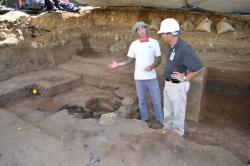 Ylig Bridge - The discovery of pebble-paved floors at archaeological sites provide a glimpse into how the ancient Chamorro people lived. "What is so significant, unique and exciting about these pebble pavings is, ... for a long time people have speculated that there aren't enough latte stones to accommodate the large population on Guam and the Northern Marianas Islands. People had to be living in another way," said Tim Rieth, principal archaeologist of International Archaeologist Research Institute Inc. out of Honolulu, which has an office on Guam. He added that there has been evidence of these pavings on a small scale across the Marianas. "In this case to have this level of exposure has never been done before on Guam or on the Northern Mariana Islands," Rieth said. He went on to explain that the three pavements were probably part of a larger community that had latte stone sets. Pebble pavings were found one meter below the surface of the ground. The pebble-paved floors were made up of coral and pumice pebbles and deeply packed sand, Rieth said. The first archaeological excavations for the new bridge found sparse historical deposits containing pottery, shell and bone food remains, and shell and stone tools. The artifacts are dated in the Latte Period, from about 1000 to 1521. The remains are part of an ancient Chamorro village uncovered during construction work of the new Ylig Bridge, according to a press release from Department of Public Works. The excavation started in March 2011 but slowed when rainy weather came in July. Only recently have archaeologists been able to see the full details of this site. The archaeological team is now mapping the site and sending samples of soil to have it carbon-dated.
Ylig Bridge - The discovery of pebble-paved floors at archaeological sites provide a glimpse into how the ancient Chamorro people lived. "What is so significant, unique and exciting about these pebble pavings is, ... for a long time people have speculated that there aren't enough latte stones to accommodate the large population on Guam and the Northern Marianas Islands. People had to be living in another way," said Tim Rieth, principal archaeologist of International Archaeologist Research Institute Inc. out of Honolulu, which has an office on Guam. He added that there has been evidence of these pavings on a small scale across the Marianas. "In this case to have this level of exposure has never been done before on Guam or on the Northern Mariana Islands," Rieth said. He went on to explain that the three pavements were probably part of a larger community that had latte stone sets. Pebble pavings were found one meter below the surface of the ground. The pebble-paved floors were made up of coral and pumice pebbles and deeply packed sand, Rieth said. The first archaeological excavations for the new bridge found sparse historical deposits containing pottery, shell and bone food remains, and shell and stone tools. The artifacts are dated in the Latte Period, from about 1000 to 1521. The remains are part of an ancient Chamorro village uncovered during construction work of the new Ylig Bridge, according to a press release from Department of Public Works. The excavation started in March 2011 but slowed when rainy weather came in July. Only recently have archaeologists been able to see the full details of this site. The archaeological team is now mapping the site and sending samples of soil to have it carbon-dated.
http://www.guampdn.com/article/20120223/NEWS01/202230315
MAROC – 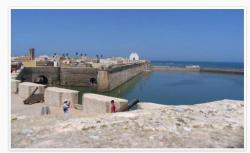 Moulay Abdellah - Un site archéologique a été découvert de manière fortuite, vendredi dernier, par les ouvriers d'une entreprise d'assainissement qui effectuait, depuis quelques mois, des travaux dans la commune rurale de Moulay Abdellah, province d'El Jadida. «Il s'agit de la découverte en sous-sol de structures archéologiques dont deux colonnes de belle facture, réalisées en pierre de taille (grès calcaire) et de forme cylindrique, ce qui rappelle, en forme réduite, les colonnes de la mosquée Hassan de Rabat», a expliqué à la MAP, l'archéologue Aboulkacem Chebri, directeur du Centre d'études et de recherches sur le patrimoine maroco-lusitanien (CERPML). Difficile à présent d'avancer une datation de ces découvertes, a-t-il dit, précisant que les photos prises in situ laissent croire que «ces colonnes remontraient peut-être à l'époque médiévale». Cette découverte, qui a eu lieu au croisement de rue La Liberté et du boulevard Mohammed V tout près d'un mausolée, consiste en des colonnes couronnées chacune d'un chapiteau de forme carrée, a-t-il noté, ajoutant que le site donne à voir aussi un mur appareillé. La zone de Moulay Abdallah est connue pour sa richesse en vestiges et monuments depuis la préhistoire (grottes d'Al-Khanzira de quelques 100.000 ans) passant par l'époque phénicienne et des Royaumes berbères du Maroc.
Moulay Abdellah - Un site archéologique a été découvert de manière fortuite, vendredi dernier, par les ouvriers d'une entreprise d'assainissement qui effectuait, depuis quelques mois, des travaux dans la commune rurale de Moulay Abdellah, province d'El Jadida. «Il s'agit de la découverte en sous-sol de structures archéologiques dont deux colonnes de belle facture, réalisées en pierre de taille (grès calcaire) et de forme cylindrique, ce qui rappelle, en forme réduite, les colonnes de la mosquée Hassan de Rabat», a expliqué à la MAP, l'archéologue Aboulkacem Chebri, directeur du Centre d'études et de recherches sur le patrimoine maroco-lusitanien (CERPML). Difficile à présent d'avancer une datation de ces découvertes, a-t-il dit, précisant que les photos prises in situ laissent croire que «ces colonnes remontraient peut-être à l'époque médiévale». Cette découverte, qui a eu lieu au croisement de rue La Liberté et du boulevard Mohammed V tout près d'un mausolée, consiste en des colonnes couronnées chacune d'un chapiteau de forme carrée, a-t-il noté, ajoutant que le site donne à voir aussi un mur appareillé. La zone de Moulay Abdallah est connue pour sa richesse en vestiges et monuments depuis la préhistoire (grottes d'Al-Khanzira de quelques 100.000 ans) passant par l'époque phénicienne et des Royaumes berbères du Maroc.
http://www.lematin.ma/express/Archeologie_Decouverte-d-un-site-a-Moulay-Abdallah/162923.html
GRECE – 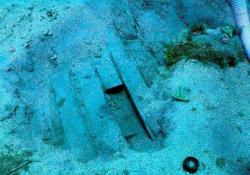 Crète - Four previously unknown shipwrecks have been discovered some 30 kilometers off the Bay of Irakleio, Crete, in recent underwater exploration conducted by the ephorate of underwater antiquities. The new finds comprise two Roman era shipwrecks, one containing 1st and 2nd-century Cretan amphorae and the other containing 5th-7th century post-Roman era amphorae, and two shipwrecks containing Byzantine amphorae, dated from the 8th-9th century and later. The finds, which were made south and east of the Dia islet, which lies 7 nautical miles north of Irakleio, were documented and taken ashore for further analysis. Three more recent shipwrecks were also discovered, as well as four other areas with archaeological material of various eras and origin which, due to their immense research interest, will be further explored in 2012 by the ephorate. The exploration was conducted to locate and record underwater antiquities in the wider area of the bay of Irakleio, as well as the Gulf of Yera of Lesvos island and the island of Tilos. (AMNA, Athens News)
Crète - Four previously unknown shipwrecks have been discovered some 30 kilometers off the Bay of Irakleio, Crete, in recent underwater exploration conducted by the ephorate of underwater antiquities. The new finds comprise two Roman era shipwrecks, one containing 1st and 2nd-century Cretan amphorae and the other containing 5th-7th century post-Roman era amphorae, and two shipwrecks containing Byzantine amphorae, dated from the 8th-9th century and later. The finds, which were made south and east of the Dia islet, which lies 7 nautical miles north of Irakleio, were documented and taken ashore for further analysis. Three more recent shipwrecks were also discovered, as well as four other areas with archaeological material of various eras and origin which, due to their immense research interest, will be further explored in 2012 by the ephorate. The exploration was conducted to locate and record underwater antiquities in the wider area of the bay of Irakleio, as well as the Gulf of Yera of Lesvos island and the island of Tilos. (AMNA, Athens News)
http://www.athensnews.gr/portal/41/53466
TURQUIE – 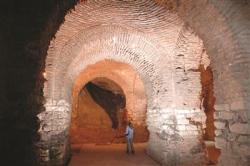 Istanbul - The walls of an ancient Byzantine palace in the protected area of Sultanahmet have been damaged and demolished to construct a hotel, eliciting anger from a number of academics. The first-degree protected area in Sultanahmet contains many archaeological and ancient sites. The situation concerning the Byzantine palace was noted Dec. 15, 2011, by officials and was reported to Fatih Municipality. According to a written statement from the foundation to protect historical artifacts, the construction should have been stopped immediately. Istanbul’s Byzantine and Ottoman remains are on the UNESCO World Heritage List.
Istanbul - The walls of an ancient Byzantine palace in the protected area of Sultanahmet have been damaged and demolished to construct a hotel, eliciting anger from a number of academics. The first-degree protected area in Sultanahmet contains many archaeological and ancient sites. The situation concerning the Byzantine palace was noted Dec. 15, 2011, by officials and was reported to Fatih Municipality. According to a written statement from the foundation to protect historical artifacts, the construction should have been stopped immediately. Istanbul’s Byzantine and Ottoman remains are on the UNESCO World Heritage List.
http://www.hurriyetdailynews.com/ancient-byzantine-wall-damaged-to-make-hotel.aspx?pageID=238&nID=14286&NewsCatID=375
ROYAUME UNI – Wanstead - After centuries lying submerged under the site of a popular park, work will begin tomorrow to explore the ruins of an ancient Roman villa. Volunteers and members of the Wanstead Parkland Communities Project (WPCP) will be clearing undergrowth from a 260 X 164 foot site in Wanstead Park on February 22 in preparation for a radar scan that will reveal the ruins of a 4th century AD villa that lies buried underneath. Evidence of Roman settlement on the site was first discovered in the 18th century, when workmen landscaping the grounds of Wanstead House discovered a mural of the god Bacchus riding a panther. The site lay ignored and concealed by undergrowth until the 1960s when amateur archaeologists unearthed pottery shards, coins, and even evidence of flues used as a part of an under-floor heating system, indicating the sumptuous wealth of ancient villa’s inhabitants. The Corporation of London would need a very strong case to be made for allowing further excavation of the site, as it has a duty to protect the buried archaeology, but the radar scan will allow archaeologists to build a three dimensional picture of the submerged ruins. Richard Arnopp, of WPCP, said: ““There were probably a string of these big Roman houses and estates along the river Roding. Evidence has been found of a cemetery for wealthy Romans in Valentines Park in Ilford.
http://www.guardian-series.co.uk/news/rbnews/9544157.WANSTEAD__Exploration_of_park_s_Roman_ruins_to_begin_tomorrow/
MALDIVES – Male - The broken glass from an attack by vandals on the National Museum here has been swept away, and the remnants of the Buddhist statues they destroyed — nearly 30 of them, some dating to the sixth century — have been locked away. But officials say the loss to this island nation’s archaeological legacy can never be recouped. In the midst of the political turmoil racking this tiny Indian Ocean nation of 1,200 islands, a half-dozen men stormed into the museum last Tuesday and ransacked a collection of coral and lime figures, including a six-faced coral statue and a 1 1/2-foot-wide representation of the Buddha’s head. Officials said the men attacked the figures because they believed they were idols and therefore illegal under Islamic and national laws. The vandalism was reminiscent of the Taliban’s demolition of the great carved Buddhas of Bamiyan in Afghanistan in early 2001, and it has raised fears here that extremists are gaining ground in the Maldives, a Sunni Muslim country that historians say converted from Buddhism to Islam in the 12th century. The country has incorporated elements of Islamic law into its jurisprudence for years. Idols cannot be brought into the country, for example, and alcohol and pork products are allowed only at resorts that cater to foreigners.
http://www.nytimes.com/2012/02/14/world/asia/political-turmoil-threatens-archaeological-treasures-in-maldives.html?_r=4&scp=2&sq=maldives&st=cse
ITALIE – 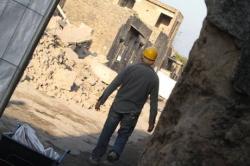 Pompei – A yard-long piece of plaster fell off the ancient Temple of Jupiter in Pompeii on Wednesday, the archaeological superintendency said. The portion broke off from the external face of the east wall of the cell of the temple in an area without frescoes. Supervisors at the site said they had already collected the fragments and would reattach them on site.
Pompei – A yard-long piece of plaster fell off the ancient Temple of Jupiter in Pompeii on Wednesday, the archaeological superintendency said. The portion broke off from the external face of the east wall of the cell of the temple in an area without frescoes. Supervisors at the site said they had already collected the fragments and would reattach them on site.
http://www.ansa.it/web/notizie/rubriche/english/2012/02/22/visualizza_new.html_102469065.html